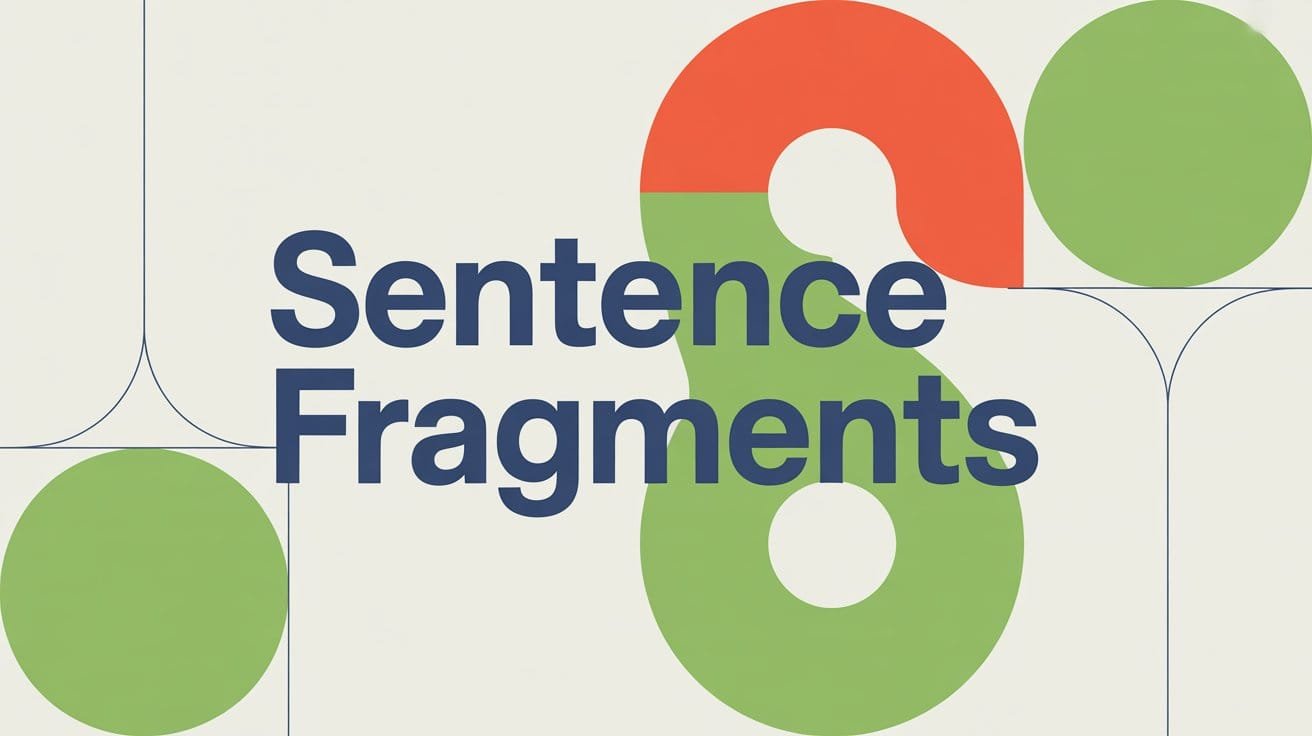A sentence fragment is a group of words that looks like a sentence but doesn’t express a complete thought. It might be missing a subject, a verb, or both. Sometimes, it’s just a leftover piece of a sentence that was never fully developed.
Sentence fragments can confuse readers, especially in formal writing, where clarity matters most. In this article, you’ll learn what sentence fragments are, how to spot them, why they happen, and how to fix them, along with examples that make everything easier to understand.
What Is a Sentence Fragment?
A sentence fragment is an incomplete sentence. It may look like a full sentence on the surface, but it’s missing one or more essential parts—usually a subject, a verb, or a complete thought.
To be a complete sentence in English, you need:
- A subject (who or what the sentence is about)
- A verb (what the subject is doing or being)
- A complete idea that can stand on its own
Example:
Fragment: Waiting at the bus stop.
(This is not a complete sentence because we don’t know who is waiting.)
Complete sentence: Mia was waiting at the bus stop.
(Now we have a subject, a verb, and a complete thought.)
Fragments are often the result of incomplete editing or casual writing. Recognizing them is the first step toward clearer and more confident writing.
Common Types of Sentence Fragments
Sentence fragments come in many forms. Some are missing a subject or verb, while others are dependent clauses or incomplete phrases. Here are the most common types, with clear examples for each.
1. Missing Subject
A sentence needs someone or something performing the action. Without a subject, the sentence is incomplete.
❌ Walked to the station before sunrise.
✔ Jonah walked to the station before sunrise.
2. Missing Verb
Sometimes a group of words has a subject but no action or linking verb.
❌ The girl in the yellow raincoat.
✔ The girl in the yellow raincoat smiled at us.
3. Dependent Clause Fragment
A dependent clause begins with words like because, although, or when and can’t stand alone as a sentence.
❌ Because she missed the last train.
✔ Because she missed the last train, she stayed overnight at a friend’s house.
4. Phrase Fragments
Phrases that don’t include a subject-verb combination can’t function as complete sentences.
Participial Phrase:
❌ Carrying a heavy backpack through the hallway.
✔ He was carrying a heavy backpack through the hallway.
Infinitive Phrase:
❌ To apply for the scholarship before the deadline.
✔ She planned to apply for the scholarship before the deadline.
5. Afterthought Fragments
Phrases that feel tacked on at the end of a sentence often lack structure.
❌ I packed everything I needed. Such as a flashlight and extra batteries.
✔ I packed everything I needed, such as a flashlight and extra batteries.
These types of fragments are common in both casual and formal writing. The next step is understanding why they happen and how to fix them.
Why Sentence Fragments Occur
Sentence fragments often appear by accident—especially when writing quickly, editing on the go, or trying to sound conversational. While some fragments are intentional for style or tone, many are simply the result of missing parts or incomplete revisions.
Common reasons sentence fragments happen:
1. Incomplete Editing
Writers may cut a sentence during editing and forget to reconnect it or rewrite it fully.
2. Informal or Casual Writing
In text messages, notes, or creative pieces, fragments might feel natural or even purposeful. But in formal writing, they can weaken clarity.
3. Misunderstanding Sentence Structure
Some fragments begin with conjunctions like “because” or “although,” making them sound complete—but they’re not unless joined with a full sentence.
4. Emphasis or Style (Intentional Use)
In dialogue or creative writing, fragments are sometimes used for effect:
So unfair.
Not a chance.
These work when the context fills in the missing parts, but they still aren’t grammatically complete sentences.
The key is knowing when a fragment is a mistake—and when it’s a conscious choice. Next, we’ll look at how to fix sentence fragments so your writing remains clear and complete.
How to Fix Sentence Fragments
Once you know what a sentence fragment looks like, fixing it usually comes down to one of three strategies: attaching it to a nearby sentence, adding missing parts, or rewriting it completely. Here’s how each method works.
1. Attach the Fragment to a Nearby Sentence
If the fragment is part of a thought already expressed, you can combine them into one complete sentence.
❌ She walked in late. Because the train was delayed.
✔ She walked in late because the train was delayed.
2. Add the Missing Subject or Verb
If the sentence lacks a subject, a verb, or both, simply add what’s missing.
❌ Hiding behind the curtain.
✔ The cat was hiding behind the curtain.
3. Rewrite the Fragment
Sometimes, the easiest fix is to rework the sentence for clarity and flow.
❌ Such as the heater and spare blankets.
✔ We brought several items to the cabin, such as the heater and spare blankets.
These quick adjustments can turn incomplete thoughts into strong, well-structured sentences.
When Is It Okay to Use Sentence Fragments?
Not all fragments are mistakes. In certain situations, writers use sentence fragments on purpose to create a specific tone, rhythm, or dramatic effect. While not suitable for formal writing, they can be effective in the right context.
1. Creative Writing and Dialogue
Fragments can make writing sound more natural and conversational, especially in fiction or personal storytelling.
“You actually did it?”
“Of course. No doubt at all.”
These aren’t full sentences, but in dialogue, they reflect how people actually speak.
2. Emphasis and Style
A short fragment can be used after a full sentence to create contrast or highlight an idea.
She had prepared for every possible outcome. Except this one.
3. Headlines, Captions, and Notes
In advertising, journalism, or quick instructions, fragments are common and often expected.
No time to waste.
Perfect for cold mornings.
Important: Bring your ID.
In these cases, context fills in what’s missing so the reader still understands the message.
While fragments can be effective in creative or casual writing, they should be avoided in academic, business, or formal writing unless used with clear intent.
FAQs
What is a sentence fragment?
A sentence fragment is a group of words that looks like a sentence but lacks a subject, a verb, or a complete thought. It doesn’t express a full idea on its own.
How can I identify a sentence fragment?
Check whether the sentence has a subject and a verb and whether it expresses a complete idea. If any of these are missing, it’s likely a fragment.
Are sentence fragments always incorrect?
Not always. Fragments are usually errors in formal writing, but they can be used intentionally in creative writing, conversation, or for stylistic effect.
Can sentence fragments be used in formal writing?
In general, no. Formal writing requires complete sentences. Fragments should only be used deliberately and in limited contexts, like quotations or headings.
What are some tips to avoid sentence fragments?
Always check for a subject and a verb. Read your writing out loud to catch incomplete ideas. If something feels abrupt or unfinished, it may need revision.



